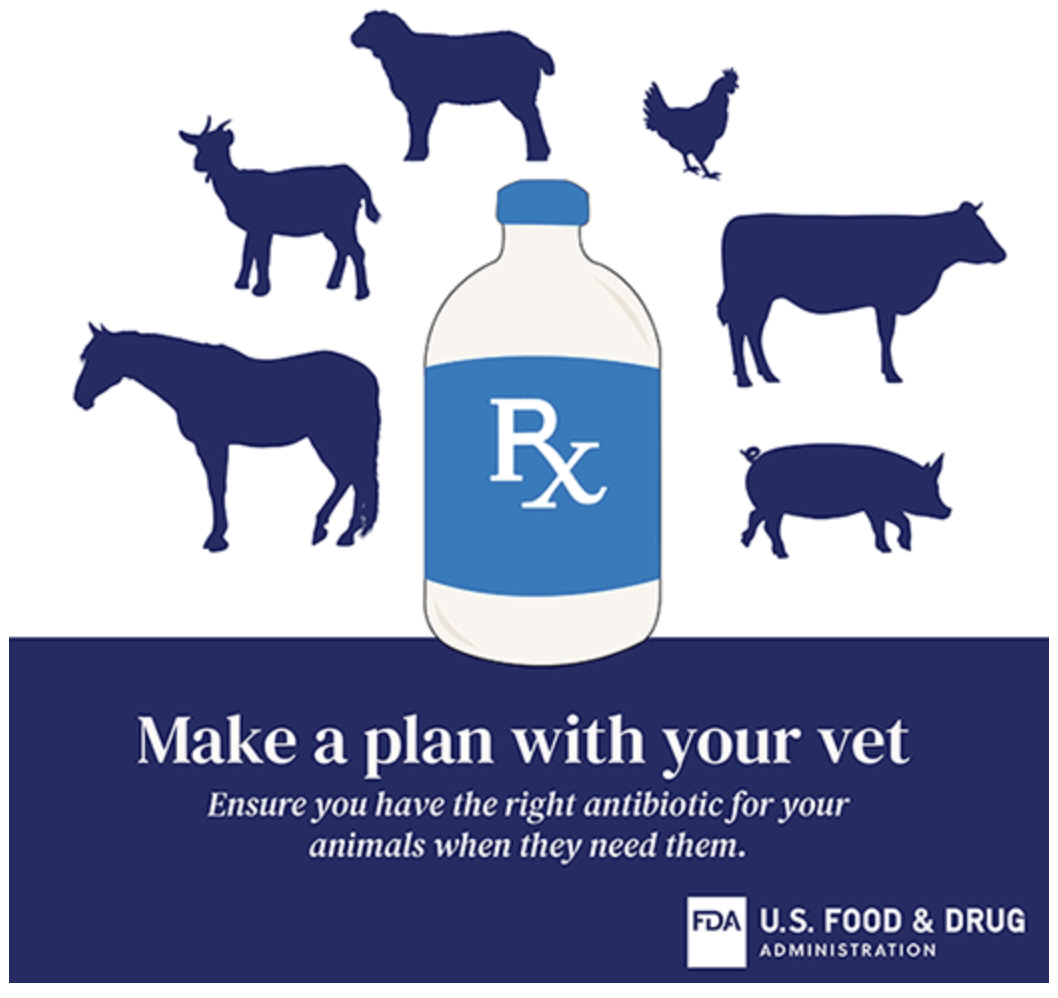VFD art

U.S. Food and Drug Administration
A U.S. Food and Drug Administration poster urges animal owners to consult with veterinarians in preparation for a change that will put nearly 100 drug products, currently available over the counter, out of reach without a prescription. See the full poster
here.
As part of a multi-step campaign by the U.S. Food and Drug Administration to stem overuse and misuse of antimicrobial drugs, nearly 100 veterinary products that have been available over the counter will require a prescription after June 11.
The products represent the last 4% of "medically important" antimicrobial veterinary drugs that federal regulators are circumscribing in order to slow pathogens' evolution toward resisting the medications. Drugs deemed medically important are those that are taken by human as well as veterinary patients.
The other 96% of medically important antimicrobial drugs used in nonhuman animals already have been brought under veterinary oversight during the past decade, according to the FDA.
Previously, such products were widely accessible as ingredients added to livestock feed and water, actions that didn't come under veterinarians' purview.
Requiring veterinarians' involvement "can help guide the judicious use of antimicrobials," which is necessary to help "slow the development of antimicrobial resistance and preserve the effectiveness of these drugs in both humans and animals," the FDA maintains.
A list posted by the FDA, current as of Jan. 23, shows 93 discrete products affected. They represent a mix of pioneer and generic drugs, including injectables. Some have the same active ingredient, such as oxytetracycline, gentamycin, sulfamethazine, lincomycin, penicillin or erythromycin, among others.
While the majority are labeled for use in food animals, 16 are labeled for both food and companion animals, and two are specific to companion animals, according to the FDA. Together, the drugs are indicated for use in cattle, swine, chickens, turkeys, horses, goats, sheep, cats and/or dogs, the agency said.
The University of Missouri Extension has posted brand names of affected products. (The cooperative extension service is a program at land-grant institutions such as the University of Missouri that provides agricultural expertise to the public.)
In an FAQ for farmers and ranchers, the FDA says that while drug companies are being asked to deem affected product entering the market after June 11 as prescription items, the agency will "allow existing inventory of OTC-labeled product that may already be in distribution channels to deplete."
In other words, older OTC products do not have to be withdrawn or relabeled. That means "There may be a period of time when there are both OTC-labeled and prescription-labeled products in distribution," the FDA notes.
Once inventory of OTC-labeled products is depleted, animal owners may find that they cannot obtain the products where they used to, according to an article published by the University of Nebraska-Lincoln Institute of Agriculture and Natural Resources. "What this [change] means for many producers is that products that they may have purchased from the local feed store, farm supply, or local co-op may no longer be on those store shelves" because the businesses do not have the capability "of acting as a 'pharmacy,' which requires the ability to review veterinary authorized prescriptions and track refills of those prescription products."
The authors, Dr. Becky Funk and Jesse Fulton, both of Nebraska Extension, add, "It is important to remember that these critical products are not being removed from the marketplace, but instead being brought under veterinary oversight in order to combat overuse/misuse due to OTC access."
The FDA, in its FAQ, recommends that farmers and ranchers consult with a veterinarian ahead of the transition period to put a plan in place, "including a plan for getting access to appropriate antimicrobial products ... when a veterinary visit is not feasible or not considered necessary by the veterinarian."
The agency states that "veterinarians are generally not required to examine each individual animal for which a prescription is issued, as long as the veterinarian has established a valid VCPR [veterinarian-client-patient relationship] with the farmer or rancher that owns or cares for the animal(s) in need of treatment." VCPR requirements are set by states and vary among jurisdictions.
In an interview by email, Funk said that many producers do not have established relationships with veterinarians and "have heavily utilized OTC products as substitutes" for comprehensive veterinary care." These include small businesses that are "accustomed to DIY animal health," she said, adding: " 'Back yard' or 'cottage' livestock producers, which we saw a huge growth [in] during and post-Covid, many of these clients tend to DIY, as well." Such operations often lack the volume of livestock to justify herd visits and may need help understanding the difference between drugs meant for companion versus food animals, said Funk, who is also a veterinary school faculty member.
Owners of small ruminant species such as goats and sheep also may lack established relationships with veterinarians "because it can be challenging to find practitioners that have some comfort level with species outside the major livestock species such as cattle and hogs," Funk pointed out.
On veterinarians' side, Funk anticipates that the switch from OTC to Rx will be relatively smooth. "[W]e are in our comfort zone, so to speak, dealing with drugs that we already have a familiarity with ..." she said. What adjustments are required of practitioners will be more in the realm of "housekeeping-type items," she said, like documenting that VCPRs are in place for new clients and training office staff to not sell affected products over the counter.
"That's not to say that conversations with some of our clients, or producers that aren't clients and need products, won't be challenging," Funk said, "but at least from a logistics standpoint, I don't expect too many hiccups."
The change from OTC to Rx status isn't mandated by the government but was agreed to by drugmakers. The FDA has been working since 2012 to tighten oversight of antimicrobial drug use, including of antibiotics, in the food-animal realm.